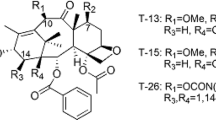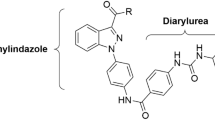Abstract
Using a regrowth-delay assay, we investigated structure/activity relationships for the enhancement by electron-affinic agents of the anti-tumour effect of the nitrosourea CCNU against the KHT sarcoma in C3H mice. A series of neutral 2-nitroimidazoles similar in electron affinity but varying in octanol/water partition coefficient (PC) over 4 orders of magnitude (0.016- greater than 200, Misonidazole = 0.43) were examined at a fixed dose of 2.5 mmol/kg. A parabolic (quadratic) dependence of activity on log PC was observed. Analogues more hydrophilic than misonidazole (MISO) were inactive as were those with very high PCs (greater than 20). Those with PC 0.43--20 were usually more active than MISO, some considerably so. The fairly lipophilic 5-nitroimidazoles nimorazole and metronidazole (METRO) had similar activity to MISO, despite their reduced electron affinity. Two basic 2-nitroimidazoles more efficient as radiosensitizers in vitro likewise showed activity comparable to MISO. We also investigated several agents more electron-affinic than MISO, including some non-nitro compounds. Most were inactive at maximum tolerated doses, but nitrofurazone showed reasonable activity. Sensitizer dose-response curves were obtained for MISO, METRO and two of the most effective agents, benznidazole (Ro 07-1051) and Ro 07-1902. The two latter agents were both considerably more active than MISO at low doses (0.1--0.9 mmol/kg). These studies indicate that the structural features of electron-affinic agents responsible for the enhancement of KHT tumour response to CCNU, are quite different from those affecting radiosensitization, lipophilicity being particularly important. The microsomal enzyme-inhibitor SKF 525A increased the anti-tumour effect of CCNU, suggesting inhibition of CCNU metabolism as one possible mechanism contributing to chemosensitization by lipophilic electron-affinic agents in mice.
This is a preview of subscription content, access via your institution
Access options
Subscribe to this journal
Receive 24 print issues and online access
$259.00 per year
only $10.79 per issue
Buy this article
- Purchase on Springer Link
- Instant access to full article PDF
Prices may be subject to local taxes which are calculated during checkout
Similar content being viewed by others
Rights and permissions
About this article
Cite this article
Workman, P., Twentyman, P. Structure/activity relationships for the enhancement by electron-affinic drugs of the anti-tumour effect of CCNU. Br J Cancer 46, 249–259 (1982). https://doi.org/10.1038/bjc.1982.190
Issue Date:
DOI: https://doi.org/10.1038/bjc.1982.190
This article is cited by
-
2-Nitroimidazole potentiation of nitrosourea induced cytotoxicity in subcutaneous implants of rat 9L brain tumor cells
Journal of Neuro-Oncology (1991)
-
Clinical pharmacokinetics of oral CCNU (Lomustine)
Cancer Chemotherapy and Pharmacology (1985)
-
Mitomycin-C plus metronidazole in advanced carcinoma of the breast
Breast Cancer Research and Treatment (1985)
-
Treatment of malignant gliomas in adults with BCNU plus metronidazole
Journal of Neuro-Oncology (1984)



